Thanks for @Oryx
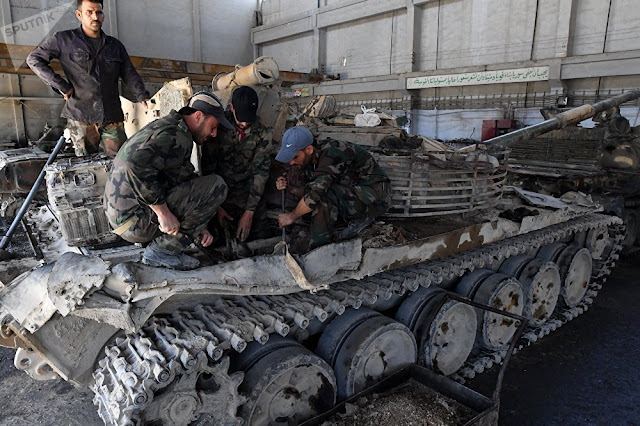
By Stijn Mitzer
The following photos were taken during a visit of a Russian journalist to a small armour repair facility in the suburbs of Damascus in June 2017. While already several years old – with several of the armoured fighting vehicles pictured likely having been lost to combat damage since – the images nevertheless provide an interesting insight into the inner workings of a small Syrian tank workshop.
Even though a job as a mechanic in a conflict is usually a guarantee of relative safety, this particular workshop was unique in that it served both as an armour repair facility and as a defensive structure to stop any rebel incursions from Jobar. In fact, the facility was located (33°32'2"N 36°20'11"E) only some 300 metres away from the actual frontline! Fortunately for the mechanics serving at the facility, no such surprise raids took place before the last pocket of resistance in Jobar was neutralised in March 2018. As a result, the images we discuss here are the rare exception where we get to examine such a workshop while it is still operational.
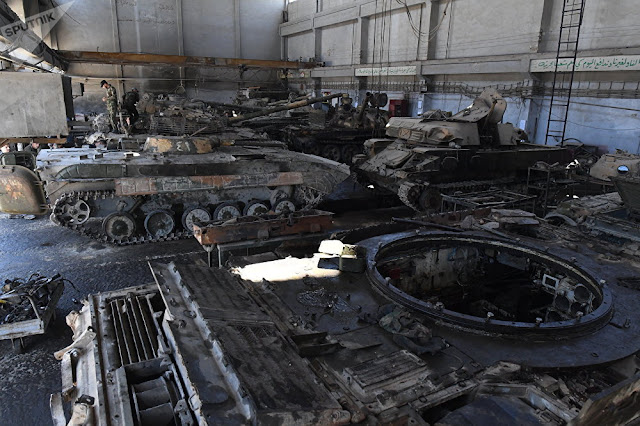
In the image below, the sad remains of a T-55(A)MV lay in front of a pile of rusty BMP-1 tracks. Having been stripped of most of its components, including nearly all of the Kontakt-1 explosive reactive armour (ERA) tiles on the turret and hull, it appears that this particular T-55 ended its career as a donor vehicle: keeping other vehicles of the same type running, presumably after suffering some type of irreparable damage in combat. Also note the collapsed roof in the background, which really drives home the run-down status of this facility.

Three T-55As still in pristine condition stand guard outside the repair facility. Their good condition is a far cry from the T-55 above or most other T-55s still operational in Syria for that matter. While the vehicles might look ready to head out to the frontline, satellite imagery shows that these tanks were parked in the exact same location from 2015 to early 2018, making it likely they belonged to a resident unit that was tasked with defending the workshop and the area that surrounds it against possible attacks coming from rebel-held Jobar.
Note that the headlights, infrared searchlight and sighting systems are all protected by sandbags in an attempt to protect them from shrapnel from shell or rocket fire landing nearby. As visible on the building behind, the facility came under repeated attacks of small arms and presumably mortar fire, which could inflict serious damage on the otherwise unprotected optical/electrical devices.

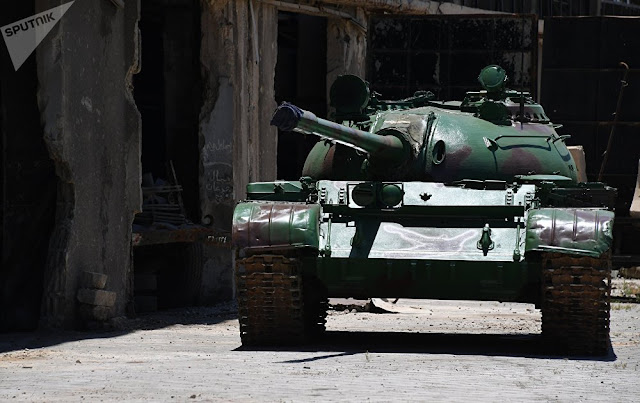
Next we see two T-72s that couldn't be more different in the task they fulfill. On the left, a T-72 'Ural' that has been converted into a towing vehicle to haul AFVs that can't move on their own around the facility – on the right, a Syrian T-72AV deprived of all its Kontakt-1 explosive reactive armour. This T-72AV is likely operated by a training unit, with the explosive reactive armour removed for use with other tanks serving on the frontline which obviously need it more direly.
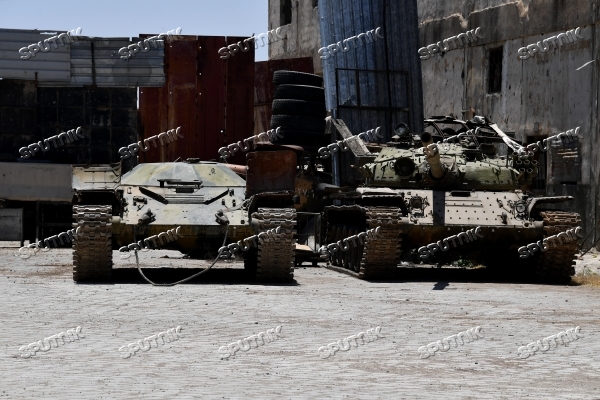
The workshop's motor pool quietly gathers dust in one of the storage halls of the facility. Having largely abandoned its aging fleet of Soviet trucks in favour of Russian-delivered GAZ, Ural and KamAZ trucks as well as more reliable and fuel-efficient commercially available vehicles, trucks like the ZIL-131, ZIL-157 and Ural-375 that once formed the backbone of the Syrian Arab Army's vehicle park now rust away in abandoned corners of SyAA bases all throughout Syria.
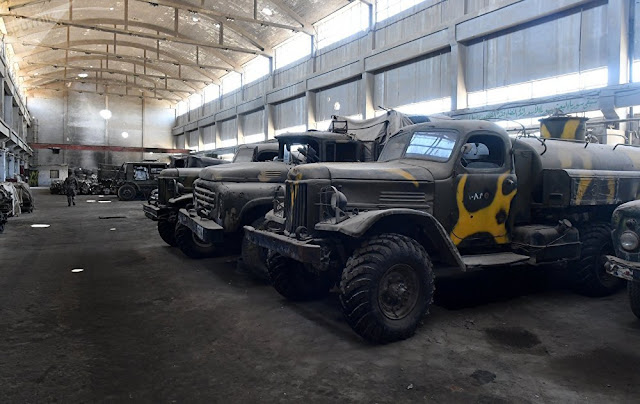
For All Article :
https://www.oryxspioenkop.com/2020/08/a-look-inside-damascus-armour-repair.html

By Stijn Mitzer
The following photos were taken during a visit of a Russian journalist to a small armour repair facility in the suburbs of Damascus in June 2017. While already several years old – with several of the armoured fighting vehicles pictured likely having been lost to combat damage since – the images nevertheless provide an interesting insight into the inner workings of a small Syrian tank workshop.
Even though a job as a mechanic in a conflict is usually a guarantee of relative safety, this particular workshop was unique in that it served both as an armour repair facility and as a defensive structure to stop any rebel incursions from Jobar. In fact, the facility was located (33°32'2"N 36°20'11"E) only some 300 metres away from the actual frontline! Fortunately for the mechanics serving at the facility, no such surprise raids took place before the last pocket of resistance in Jobar was neutralised in March 2018. As a result, the images we discuss here are the rare exception where we get to examine such a workshop while it is still operational.

In the image below, the sad remains of a T-55(A)MV lay in front of a pile of rusty BMP-1 tracks. Having been stripped of most of its components, including nearly all of the Kontakt-1 explosive reactive armour (ERA) tiles on the turret and hull, it appears that this particular T-55 ended its career as a donor vehicle: keeping other vehicles of the same type running, presumably after suffering some type of irreparable damage in combat. Also note the collapsed roof in the background, which really drives home the run-down status of this facility.

Three T-55As still in pristine condition stand guard outside the repair facility. Their good condition is a far cry from the T-55 above or most other T-55s still operational in Syria for that matter. While the vehicles might look ready to head out to the frontline, satellite imagery shows that these tanks were parked in the exact same location from 2015 to early 2018, making it likely they belonged to a resident unit that was tasked with defending the workshop and the area that surrounds it against possible attacks coming from rebel-held Jobar.
Note that the headlights, infrared searchlight and sighting systems are all protected by sandbags in an attempt to protect them from shrapnel from shell or rocket fire landing nearby. As visible on the building behind, the facility came under repeated attacks of small arms and presumably mortar fire, which could inflict serious damage on the otherwise unprotected optical/electrical devices.


Next we see two T-72s that couldn't be more different in the task they fulfill. On the left, a T-72 'Ural' that has been converted into a towing vehicle to haul AFVs that can't move on their own around the facility – on the right, a Syrian T-72AV deprived of all its Kontakt-1 explosive reactive armour. This T-72AV is likely operated by a training unit, with the explosive reactive armour removed for use with other tanks serving on the frontline which obviously need it more direly.

The workshop's motor pool quietly gathers dust in one of the storage halls of the facility. Having largely abandoned its aging fleet of Soviet trucks in favour of Russian-delivered GAZ, Ural and KamAZ trucks as well as more reliable and fuel-efficient commercially available vehicles, trucks like the ZIL-131, ZIL-157 and Ural-375 that once formed the backbone of the Syrian Arab Army's vehicle park now rust away in abandoned corners of SyAA bases all throughout Syria.

For All Article :
https://www.oryxspioenkop.com/2020/08/a-look-inside-damascus-armour-repair.html


